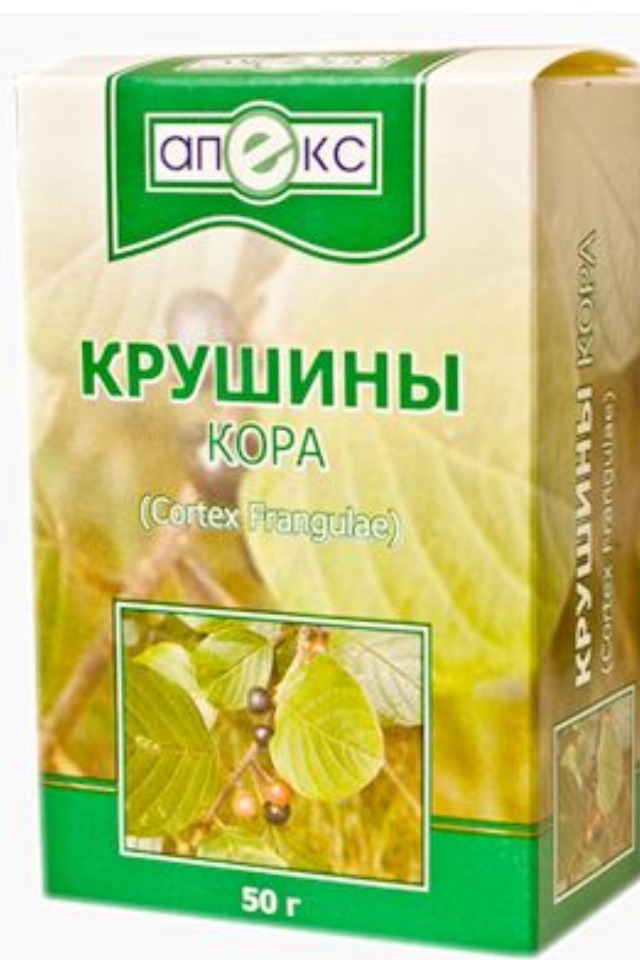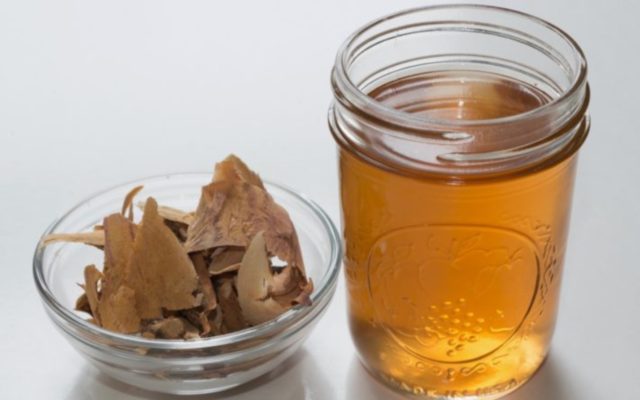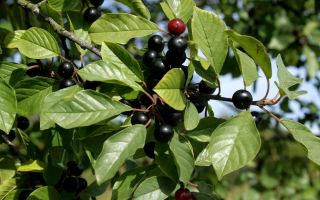Content
- 1 The chemical composition of buckthorn bark
- 2 Useful properties of buckthorn bark
- 3 Harm of buckthorn bark
- 4 Contraindications to buckthorn bark
- 5 How to take buckthorn bark
- 6 Buckthorn bark application
- 7 Buckthorn bark during pregnancy
- 8 Collection and storage rules
- 9 Conclusion
- 10 Reviews of the beneficial properties of buckthorn bark
Buckthorn is a perennial shrub whose fruits are not edible. For a long time, this culture was used only in weaving, since its bark gave a persistent yellow dye. And only over time, the plant acquired the status of medicinal, when the laxative properties of the bark were revealed. Now the culture is widely used in pharmaceuticals. But before using it, it is necessary to study in detail the beneficial properties and contraindications to buckthorn bark, which will allow the correct use of this therapeutic component.

The chemical composition of buckthorn bark
Fresh buckthorn bark contains frangularoside, which causes vomiting in humans. But during storage, it is converted into glucofrangulin, which has no side effects. Therefore, it is recommended to use buckthorn for treatment, which has lain for at least one year, or after heat treatment at a temperature of +100 degrees for 1 hour.
The chemical composition of medicinal raw materials includes:
- anthraquinones;
- tannins;
- sugar;
- flavonoids;
- bitter substances;
- resin;
- pectins;
- gum;
- organic acids;
- alkaloids;
- essential oil.
Due to such a variety of components, buckthorn is used to treat many diseases.
Useful properties of buckthorn bark
This healing component is valued for its mild laxative effect, which is due to the high content of anthraglycosides. When they disintegrate in the intestine, the mucous membrane is irritated, and this increases peristalsis and thereby accelerates defecation. The laxative effect does not occur immediately, but 10-12 hours after ingestion.
Other medicinal properties:
- anti-inflammatory;
- antiviral;
- diuretic;
- antispasmodic;
- diaphoretic;
- antiparasitic.
The combination of these qualities allows the component to be used to treat many diseases.
Indications for the use of buckthorn bark:
- chronic constipation;
- diseases of the digestive system, kidneys;
- urolithiasis disease;
- gastritis, ulcer;
- colic;
- various disorders of the cardiovascular system;
- hemorrhoids;
- hormonal disruption with menopause;
- skin diseases;
- nervous disorders.
The effectiveness of raw materials has also been proven in the presence of excess weight and obesity. And in combination with protein diets, it helps to achieve quick results.

The beneficial properties of buckthorn bark have been proven for weight loss. Its combination with fennel, mint and parsley leaves helps to get rid of extra pounds.
The diuretic property of the bush helps in the treatment of dropsies, edema, and also helps to remove sand from the kidneys and gallbladder. It has been proven effective in the treatment of boils and other serious skin diseases.
Buckthorn bark is also used for parasites. In this case, it must be used together with tansy. Where the latter has a depressing effect on parasites, and the former promotes their excretion from the body.
Harm of buckthorn bark
With prolonged use, the body gets used to the action of raw materials. This leads to problematic bowel movements. The component can harm the body if the dosage is constantly exceeded, which causes cramps in the abdomen and too watery stools.
Also, prolonged uncontrolled intake of buckthorn bark can provoke hypokalemia, which indicates a low concentration of potassium in the blood. This condition is accompanied by chronic fatigue, muscle cramps, and abnormal heart rhythms.
Contraindications to buckthorn bark
The use of medicinal raw materials has a number of limitations. Ignoring them can lead to serious health consequences.
Main contraindications:
- pregnancy:
- period of breastfeeding;
- diseases of the reproductive organs;
- the presence of malignant tumors;
- predisposition to uterine bleeding;
- Crohn's disease;
- age up to three years;
- empyema of the gallbladder.
The medicinal component is not prescribed for:
- appendicitis;
- enteritis;
- intestinal obstruction;
- spastic constipation;
- colitis.
How to take buckthorn bark
In the pharmacy, you can buy ready-made preparations based on raw materials. It can be:
- collection;
- syrup;
- tincture;
- tablets.
They must be taken as prescribed by a doctor, since only an experienced specialist will be able to select a medicine depending on the individual characteristics of the patient.

The daily intake of syrup is 5-10 ml. Tablets are recommended to be taken in the evening before going to bed, 1-2 pcs. And the tincture should be diluted with water. The consumption rate is 20-30 drops per 70 ml of liquid three times a day. It is recommended to take medications 15 minutes in advance. before meals.
Pharmacy syrup can be used for children over three years of age as a laxative.
Permissible daily dosage:
- ¼ h. L. - from three to four years;
- ½ tsp - from five to eight years old;
- 1-1.5 tsp - from nine to eleven years old.
It is recommended to give the medicine on an empty stomach. If after application the child has a rash or a stomach ache, then therapy should be discontinued.
Buckthorn bark application
The bark has found wide application in folk medicine. The preparation of medicinal products based on it does not require complex manipulations. But at the same time, they help solve many health problems.
Folk remedies recipes:
- Decoction... To prepare it, you need to pour 20 g of buckthorn bark with 400 ml of water. Boil the mixture over low heat for half an hour. Cool and then clean. Take 100 ml at night. A decoction of buckthorn bark is recommended for constipation, parasites and urolithiasis.
- Tincture... For its preparation, it is necessary to pour 25 g of raw materials with 500 ml of vodka. Pour the mixture into a glass container and close the lid tightly. Stand for two weeks, shaking the container regularly. Apply the tincture to treat skin diseases. Moisten a cotton swab in the product and apply to the affected area three times a day.
- Infusion... For preparation, it is recommended to steam 15 g of raw materials with 200 ml of boiling water. Insist the remedy for 8 hours, and then strain. Take 1 tbsp. l. before bedtime. This buckthorn bark remedy is especially useful for cleansing the intestines.

Buckthorn bark during pregnancy
Buckthorn bark differs not only in useful properties for women, during the period of gestation, it can provoke the appearance of edema of the pelvic organs. Therefore, it cannot be used at this time.
Collection and storage rules
To obtain medicinal raw materials, it is necessary to collect the bark in early spring. This should be done when the temperature is above zero, but leaves have not yet grown on the bush. For harvesting, young branches and shoots of buckthorn should be selected. They need to be cut at a height of 10 cm above the soil surface, which will allow the plant to quickly recover from the stress.
To easily remove the buckthorn bark, you need to initially make transverse cuts at a distance of 10-15 cm. And then connect them with one longitudinal cuts. In this case, the buckthorn bark will easily separate from the shoot in the form of a tube or groove.
Drying of the medicinal component can be carried out outdoors in the shade or in a well-ventilated area. To do this, the buckthorn bark should be laid out in one layer so that its parts do not come into contact with each other.
After drying, the healing collection must be carefully sorted out and all blackened pieces and wood residues must be removed. It is necessary to store buckthorn bark in a pressed form in a tightly closed container. The shelf life is five years.
Conclusion
Having studied the beneficial properties and contraindications to buckthorn bark, we can say for sure in which cases this medicinal component should be taken, and when it is better to abstain. It is also important to strictly follow the rules of admission and the indicated dosages, because the result of therapy depends on them. Ignoring it can have the opposite effect and serious health consequences.

